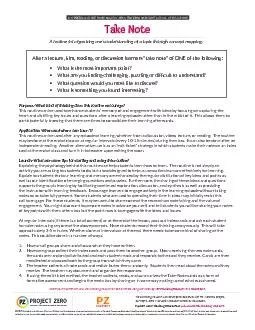

Purpose Fhat kind of thinking does this roux00740069ne encourage This routine can be used to enhance students146 memory of and engagement with ideas by focusing on capturing the heart and dis ID: 848562
Download Pdf The PPT/PDF document "A THINKING ROUTINE FROM PROJECT ZERO HAR..." is the property of its rightful owner. Permission is granted to download and print the materials on this web site for personal, non-commercial use only, and to display it on your personal computer provided you do not modify the materials and that you retain all copyright notices contained in the materials. By downloading content from our website, you accept the terms of this agreement.
1 A THINKING ROUTINE FROM PROJECT ZERO, HA
A THINKING ROUTINE FROM PROJECT ZERO, HARVARD GRADUATE SCHOOL OF EDUCATION Purpose: Fhat kind of thinking does this rou�ne encourage? This routine can be used to enhance students’ memory of and engagement with ideas by focusing on capturing the heart and distilling key issues and questions after a learning episode rather than in the midst of it. This allows them to participate fully knowing that there are times to consolidate their learning afterwards. Applica�on: Fhen and where can . use it? This routine can be used after any episode of learning, whether from a discussion, video, lecture, or reading. The routine may be done at the end of class or at regular intervals (every 10-15 minutes) during the class. It can also be done after an independent reading. Another alternative use is as an “exit ticket” strategy in which students make their note on an index card at the end of class and turn it in to teacher upon exiting the room. 2aunch: Fhat are some �ps for star�ng and using this rou�ne? Explaining the psychology behind this routine can help students learn how to learn. The routine is not simply an activity you are asking to students to do, but a tool designed to help us use out brains more effectively for learning. Explain to students that our learning and memory are enhanced by the regular distillation of key ideas and points as wellAasAourAidenti�cationAofAemergingAquestionsAandApuggles.AAFurthermoreHAtheAsharingAofAtheseAideasAandAquestionsA supports the group’s learning by facilitating continued exploration, discussion, and synthesis as well as providing the instructor with learning feedback. Encourage learners to engage actively in the learning episode without taking notes so as to be fully present. Some students who are used to spending their time in class may initially resist this callAtoAengage.AAForAtheseAstudentsHAitAmayAbeAusefulAtoAshareAsomeAofAtheAresearchAonAnoteAtakingAandAtheAvalueAofA engagement. You might also want to prepare notes in advance yourself, and tell students you will be sharing your notes of key points with them after class but the point now is to engage with the ideas and issues. At regular intervals (if there is a lot of content) or at the end of the lesson, pass out index cards and ask each student to make note using any one of the above prompts. Have students record their thinking anonymously. This will take approximately 3-5 minutes. Whether done at intervals or at the end, there needs to be some kind of sharing of the notes. This could be done in a number of ways: 1. Have small groups share and discuss what they have written. 2. Have one group collect their index cards and pass them to another group. Upon receiving the new note cards, the cards are randomly distributed and each student reads and responds to the card they receive. Cards are then recollected and passed back to the group from which they came. 3. The teacher collects all note cards and redistributes them randomly. Students then read aloud the note card they receive.AAdheAteacherAmayAdocumentAandAorganigeAtheAresponses.AA 4. ZfAusingAtheAe�itAticketAmethodHAtheAteacherAcollectsHAreadsHAandAsummarigesAtheAdake-coteAcardsAasAaAformAofA formative assessment and begins the next class by sharing or in some way making use of what was shared. with others, but it cannot be used commercially. To reference this work, please use the following: The dakeAcoteA thinkingAroutineAwasAdevelopedAbyAProjectAferoHAaAresearchAcenterAatAtheAHarvardAGraduateASchoolAofAEducation. Take Note Take Note HARVARD GRADUATE SCHOOL OF EDUCATION A rou�ne for organizing one’s understanding of a topic through concept mapping. Explore more Thinking Rou�nes at pz.harvard.edu/thinking-rou�nes Share your experience with this thinking rou�ne on social media using the hashtags #PZThinkingRou�nes #TakeNote. • What is the most important point? • WhatAareAyouA�ndingAchallengingHApugglingAorAdif�cultAtoAunderstandS • What question would you most like to discuss? • What is something you found interesting? A�er a lecture, �lm, reading, or discussion learners “take note” of ONE of the following: This thinking rou�ne was developed as part of the PZ Connect project at Project Zero, Harvard Graduate School of Educa�on. CONNECTPZ